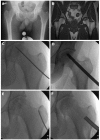Osteonecrosis of the femoral head: An update in year 2012
- PMID: 22655222
- PMCID: PMC3364317
- DOI: 10.5312/wjo.v3.i5.49
Osteonecrosis of the femoral head: An update in year 2012
Abstract
Osteonecrosis is a phenomenon involving disruption to the vascular supply to the femoral head, resulting in articular surface collapse and eventual osteoarthritis. Although alcoholism, steroid use, and hip trauma remain the most common causes, several other etiologies for osteonecrosis have been identified. Basic science research utilizing animal models and stem cell applications continue to further elucidate the pathophysiology of osteonecrosis and promise novel treatment options in the future. Clinical studies evaluating modern joint-sparing procedures have demonstrated significant improvements in outcomes, but hip arthroplasty is still the most common procedure performed in these affected younger adults. Further advances in joint-preserving procedures are required and will be widely studied in the coming decade.
Keywords: Avascular necrosis; Core decompression; Femoral head; Hip; Osteonecrosis; Total hip arthroplasty.
Figures


References
-
- Li W, Sakai T, Nishii T, Nakamura N, Takao M, Yoshikawa H, Sugano N. Distribution of TRAP-positive cells and expression of HIF-1alpha, VEGF, and FGF-2 in the reparative reaction in patients with osteonecrosis of the femoral head. J Orthop Res. 2009;27:694–700. - PubMed
-
- Lavernia CJ, Sierra RJ, Grieco FR. Osteonecrosis of the femoral head. J Am Acad Orthop Surg. 1999;74:250–261. - PubMed
-
- Malizos KN, Karantanas AH, Varitimidis SE, Dailiana ZH, Bargiotas K, Maris T. Osteonecrosis of the femoral head: etiology, imaging and treatment. Eur J Radiol. 2007;63:16–28. - PubMed
-
- Mont MA, Hungerford DS. Non-traumatic avascular necrosis of the femoral head. J Bone Joint Surg Am. 1995;77:459–474. - PubMed
-
- Mankin HJ. Nontraumatic necrosis of bone (osteonecrosis) N Engl J Med. 1992;326:1473–1479. - PubMed
LinkOut - more resources
Full Text Sources

